Blog
The Definition of a Foot Fracture

A foot fracture, also known as a broken foot, can vary in severity, from small hairline cracks to complete bone breaks. The human foot is a complex structure comprising 26 bones, making it susceptible to a variety of fracture types. Foot fractures often result from traumatic incidents, such as falls, sports injuries, or accidents. They can also occur due to repetitive stress on the foot over time, especially in athletes or individuals engaged in high-impact activities. Common symptoms of a foot fracture include pain, swelling, and bruising, and it can also be difficult to walk. A diagnosis typically involves physical examination, X-rays, or other imaging tests to determine the type and extent of the fracture. Treatment options can vary depending on the fracture's severity and location. Mild fractures may heal with rest, immobilization, and pain management. Conversely, more severe cases may require casting, surgery, or other interventions to ensure proper healing that can restore normal foot function. In conclusion, a foot fracture is a break in one or more of the foot's many bones, often resulting from trauma or repetitive stress. If you have broken your foot, it is suggested that you visit a podiatrist who can provide you with an accurate diagnosis and offer the treatment plan that is right for you.
A broken foot requires immediate medical attention and treatment. If you need your feet checked, contact Shaun J. Limon, DPM and Lisa Griffith-Limon, DPM from Limons Foot & Ankle Care. Our doctors can provide the care you need to keep you pain-free and on your feet.
Broken Foot Causes, Symptoms, and Treatment
A broken foot is caused by one of the bones in the foot typically breaking when bended, crushed, or stretched beyond its natural capabilities. Usually the location of the fracture indicates how the break occurred, whether it was through an object, fall, or any other type of injury.
Common Symptoms of Broken Feet:
- Bruising
- Pain
- Redness
- Swelling
- Blue in color
- Numbness
- Cold
- Misshapen
- Cuts
- Deformities
Those that suspect they have a broken foot shoot seek urgent medical attention where a medical professional could diagnose the severity.
Treatment for broken bones varies depending on the cause, severity and location. Some will require the use of splints, casts or crutches while others could even involve surgery to repair the broken bones. Personal care includes the use of ice and keeping the foot stabilized and elevated.
If you have any questions please feel free to contact our office located in Lakewood Ranch, FL . We offer the newest diagnostic and treatment technologies for all your foot and ankle needs.
Foot Exercises Can Improve Ballet Toe Point
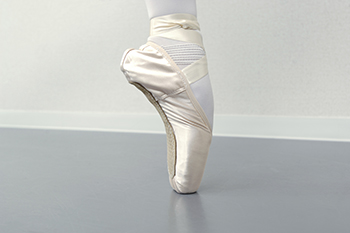
For ballet dancers, a beautifully pointed toe is not just an aesthetic requirement but also a symbol of strength and grace. Achieving a perfect pointe can be challenging, but with dedicated foot exercises, a dancer can enhance her toe point and elevate her dance performance. Begin with a simple flex and point exercise. This is done by sitting or standing with the legs extended. Slowly flex the feet, pulling the toes toward the shins, followed by pointing your toes as far as possible. Repeating this motion can help to improve flexibility and control. A resistance band flex consists of placing a resistance band around your foot and gently flex against the band's resistance. This exercise strengthens the muscles that control toe movement. An effective foot exercise is known as the marble stretch. By placing marbles on the floor and picking them up with your toes you can help to strengthen the intrinsic muscles of your feet. Additionally, writing the alphabet in the air using your big toe can be beneficial in improving toe dexterity and control. Consistent practice of these foot exercises will gradually improve your toe point and enhance performance. It is important to stretch and warm up before attempting these exercises to prevent injury. If you would like more information about how to improve your toe strength, it is suggested that you speak with a podiatrist.
Exercising your feet regularly with the proper foot wear is a great way to prevent injuries and build strength. If you have any concerns about your feet, contact Shaun J. Limon, DPM and Lisa Griffith-Limon, DPM from Limons Foot & Ankle Care. Our doctors can provide the care you need to keep you pain-free and on your feet.
Exercise for Your Feet
Exercise for your feet can help you gain strength, mobility and flexibility in your feet. They say that strengthening your feet can be just as rewarding as strengthening another part of the body. Your feet are very important, and we often forget about them in our daily tasks. But it is because of our feet that are we able to get going and do what we need to. For those of us fortunate enough to not have any foot problems, it is an important gesture to take care of them to ensure good health in the long run.
Some foot health exercises can include ankle pumps, tip-toeing, toe rises, lifting off the floor doing reps and sets, and flexing the toes. It is best to speak with Our doctors to determine an appropriate regimen for your needs. Everyone’s needs and bodies are different, and the activities required to maintain strength in the feet vary from individual to individual.
Once you get into a routine of doing regular exercise, you may notice a difference in your feet and how strong they may become.
If you have any questions please feel free to contact our office located in Lakewood Ranch, FL . We offer the newest diagnostic and treatment technologies for all your foot and ankle needs.
Gout Pain Can Be Managed
How to Safeguard Your Home From Falls
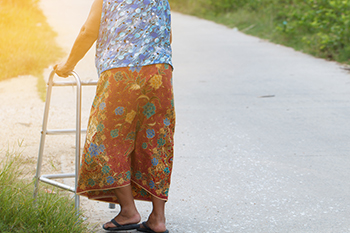
Our homes are our sanctuaries, places of comfort and security. However, they can also harbor hidden hazards that pose risks of falls, especially for children and older adults. Safeguarding your home from falls is essential for ensuring the well-being of your family. Effective fall prevention techniques can begin with good lighting. Adequate illumination in hallways, staircases, and entryways helps everyone navigate safely. Placing non-slip mats and rugs can prevent slipping on slick surfaces, such as bathroom tiles or hardwood floors. Installing handrails on staircases and in bathrooms can help to provide support, especially for those with mobility issues. Keeping walkways clear of clutter and making sure cords and cables are neatly tucked away may help to avoid tripping. Additionally, it is beneficial to regularly check and maintain the condition of flooring and stairs, and repair any loose or damaged areas promptly. By implementing these measures, you can create a safe haven, free from fall-related risks in your home. Falling can affect the feet, possibly causing daily activities to be compromised. If you would like additional information about effective fall prevention strategies, it is suggested that you speak with a podiatrist.
Preventing falls among the elderly is very important. If you are older and have fallen or fear that you are prone to falling, consult with Shaun J. Limon, DPM and Lisa Griffith-Limon, DPM from Limons Foot & Ankle Care. Our doctors will assess your condition and provide you with quality advice and care.
Every 11 seconds, an elderly American is being treated in an emergency room for a fall related injury. Falls are the leading cause of head and hip injuries for those 65 and older. Due to decreases in strength, balance, senses, and lack of awareness, elderly persons are very susceptible to falling. Thankfully, there are a number of things older persons can do to prevent falls.
How to Prevent Falls
Some effective methods that older persons can do to prevent falls include:
- Enrolling in strength and balance exercise program to increase balance and strength
- Periodically having your sight and hearing checked
- Discuss any medications you have with a doctor to see if it increases the risk of falling
- Clearing the house of falling hazards and installing devices like grab bars and railings
- Utilizing a walker or cane
- Wearing shoes that provide good support and cushioning
- Talking to family members about falling and increasing awareness
Falling can be a traumatic and embarrassing experience for elderly persons; this can make them less willing to leave the house, and less willing to talk to someone about their fears of falling. Doing such things, however, will increase the likelihood of tripping or losing one’s balance. Knowing the causes of falling and how to prevent them is the best way to mitigate the risk of serious injury.
If you have any questions, please feel free to contact our office located in Lakewood Ranch, FL . We offer the newest diagnostic and treatment technologies for all your foot care needs.
Common Causes of Swollen Feet
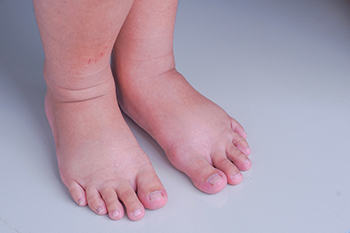
Swollen feet, while often benign, can be discomforting and may point to an underlying issue. Various factors can contribute to this condition. Prolonged standing or sitting, especially in one position, can impede proper blood circulation, leading to fluid accumulation and swelling. Wearing inadequate footwear, whether too tight or unsupportive, can restrict blood flow and aggravate the problem. Medical conditions such as hypertension or kidney disease can cause fluid retention in the lower extremities. Pregnancy also plays a role due to increased pressure on blood vessels and hormonal shifts. Injuries like sprains or fractures can trigger inflammation and swelling as part of the body's healing response. Recognizing the cause of swollen feet is important for effective management. Elevating your feet, staying hydrated, and engaging in a consistent exercise routine can be helpful. However, persistent or severe swelling demands medical attention to address the root cause. If you have swollen feet, it is suggested that you are under the care of a podiatrist who can help you to manage this condition.
Swollen feet can be a sign of an underlying condition. If you have any concerns, contact Shaun J. Limon, DPM and Lisa Griffith-Limon, DPM of Limons Foot & Ankle Care. Our doctors can provide the care you need to keep you pain-free and on your feet.
Swollen feet are a common ailment among pregnant women and people who stand or sit for extended periods. Aging may increase the possibility of swollen feet and patients who are obese often notice when their feet are swelling too. There may be medical reasons why swollen feet occur:
- Phlebitis - A condition that causes the veins to become inflamed and can also cause leg pain.
- Liver disease - This may lead to low blood levels of albumin which is a protein. This can cause fluid in the blood to pass into the tissues and several areas of the body can become swollen.
- Heart failure - When the heart doesn’t pump properly the blood that is normally pumped back to the heart can pool in the veins of the legs causing swollen feet.
- Kidney disease - One of the main functions of the kidneys is releasing excess fluid in the body. This type of condition can make it difficult for the kidneys to function properly, and as a result the feet may become swollen.
- Deep-vein thrombosis (DVT)- This is a serious condition where blood clots form in the veins of the legs. They can block the return of blood from the legs to the heart which may cause the feet to swell. It is important to be treated by a podiatrist if this condition is present.
Swollen feet can also be caused by bone and tendon conditions, including fractures, arthritis, and tendinitis. Additionally, there may be skin and toenail conditions and an infection may cause the feet to swell. Patients who take medicine to treat high blood pressure may be prone to getting swollen feet.
Many patients elevate their feet to help relieve the swelling and this is generally a temporary remedy. When a podiatrist is consulted the reason behind the swelling can be uncovered and subsequently treated.
If you have any questions please feel free to contact our office located in Lakewood Ranch, FL . We offer the newest diagnostic tools and technology to treat your foot and ankle needs.
Are Bunions Affecting Your Everyday Life?
Athlete’s Foot and How It Is Treated

Athlete's foot, medically known as tinea pedis, is a common fungal infection affecting the feet and causing itchy, red, and flaky rashes. This condition, despite its name, can affect anyone not just athletes. It thrives in warm, humid conditions like sweaty feet inside poorly ventilated shoes or walking barefoot in locker rooms or by pool areas. Symptoms can include a rash, itching, skin cracking, and burning sensations, often affecting the area between the fourth and fifth toes. Risk factors include closed shoes, excessive foot sweating, poor hygiene, living in warm environments, and weakened immune systems. Men are more susceptible to athlete’s foot than women. Diagnosis relies on typical symptoms, but tests may be necessary in uncertain cases, including UV examination and skin or nail scrapings. Treatment and prevention involve washing the feet daily, drying the feet thoroughly, and wearing cotton socks and breathable shoes. Medical treatment includes antifungal creams, ointments, or tablets prescribed by a doctor. Early treatment is essential to prevent complications, especially for individuals with underlying health conditions. If you suspect you have athlete’s foot, it is strongly suggested that you make an appointment with a podiatrist for a diagnosis and treatment plan.
Athlete’s Foot
Athlete’s foot is often an uncomfortable condition to experience. Thankfully, podiatrists specialize in treating athlete’s foot and offer the best treatment options. If you have any questions about athlete’s foot, consult with Shaun J. Limon, DPM and Lisa Griffith-Limon, DPM from Limons Foot & Ankle Care. Our doctors will assess your condition and provide you with quality treatment.
What Is Athlete’s Foot?
Tinea pedis, more commonly known as athlete’s foot, is a non-serious and common fungal infection of the foot. Athlete’s foot is contagious and can be contracted by touching someone who has it or infected surfaces. The most common places contaminated by it are public showers, locker rooms, and swimming pools. Once contracted, it grows on feet that are left inside moist, dark, and warm shoes and socks.
Prevention
The most effective ways to prevent athlete’s foot include:
- Thoroughly washing and drying feet
- Avoid going barefoot in locker rooms and public showers
- Using shower shoes in public showers
- Wearing socks that allow the feet to breathe
- Changing socks and shoes frequently if you sweat a lot
Symptoms
Athlete’s foot initially occurs as a rash between the toes. However, if left undiagnosed, it can spread to the sides and bottom of the feet, toenails, and if touched by hand, the hands themselves. Symptoms include:
- Redness
- Burning
- Itching
- Scaly and peeling skin
Diagnosis and Treatment
Diagnosis is quick and easy. Skin samples will be taken and either viewed under a microscope or sent to a lab for testing. Sometimes, a podiatrist can diagnose it based on simply looking at it. Once confirmed, treatment options include oral and topical antifungal medications.
If you have any questions, please feel free to contact our office located in Lakewood Ranch, FL . We offer the newest diagnostic and treatment technologies for all your foot care needs.
Causes and Effective Solutions for Ankle Pain
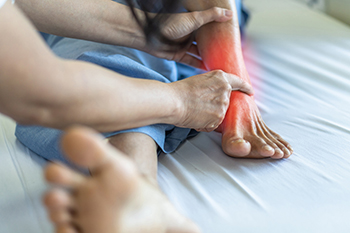
Ankle pain can be a persistent and debilitating issue that affects individuals of all ages and lifestyles. This discomfort often stems from a variety of factors, such as injuries resulting from accidents or sports-related activities, overuse, improper footwear, or underlying medical conditions. Understanding the root cause of ankle pain is crucial for implementing effective remedies. Resting and elevating the affected foot can provide initial relief by reducing inflammation while promoting healing. Gentle stretching and strengthening exercises under the guidance of a podiatrist can aid in rehabilitation and prevent future issues. Wearing supportive footwear with proper arch and ankle support, in addition to orthotic inserts, can provide stability and alleviate pain. It is suggested that you seek timely medical advice from a podiatrist if you have ankle pain, who can effectively diagnose and treat this condition.
Ankle pain can have many different causes and the pain may potentially be serious. If you have ankle pain, consult with Shaun J. Limon, DPM and Lisa Griffith-Limon, DPM from Limons Foot & Ankle Care. Our doctors will assess your condition and provide you with quality foot and ankle treatment.
Ankle pain is any condition that causes pain in the ankle. Due to the fact that the ankle consists of tendons, muscles, bones, and ligaments, ankle pain can come from a number of different conditions.
Causes
The most common causes of ankle pain include:
- Types of arthritis (rheumatoid, osteoarthritis, and gout)
- Ankle sprains
- Broken ankles
- Achilles tendinitis
- Achilles tendon rupture
- Stress fractures
- Tarsal tunnel syndrome
- Plantar fasciitis
Symptoms
Symptoms of ankle injury vary based upon the condition. Pain may include general pain and discomfort, swelling, aching, redness, bruising, burning or stabbing sensations, and/or loss of sensation.
Diagnosis
Due to the wide variety of potential causes of ankle pain, podiatrists will utilize a number of different methods to properly diagnose ankle pain. This can include asking for personal and family medical histories and of any recent injuries. Further diagnosis may include sensation tests, a physical examination, and potentially x-rays or other imaging tests.
Treatment
Just as the range of causes varies widely, so do treatments. Some more common treatments are rest, ice packs, keeping pressure off the foot, orthotics and braces, medication for inflammation and pain, and surgery.
If you have any questions, please feel free to contact our office located in Lakewood Ranch, FL . We offer the newest diagnostic and treatment technologies for all your foot care needs.
Are You Suffering From Ingrown Toenails?
Heel Pain Causes
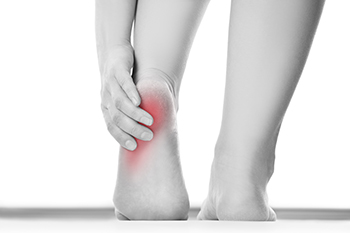
Heel pain is a common ailment that can significantly impact daily activities and quality of life. Several factors contribute to heel pain, with the most prevalent cause being plantar fasciitis, an inflammation of the thick band of tissue running across the bottom of the foot. Other culprits include Achilles tendinitis, heel spurs, and bursitis. Lifestyle factors such as excessive weight, improper footwear, and repetitive overuse during physical activities can exacerbate the condition. Effective treatments for heel pain focus on reducing inflammation, managing pain, and promoting healing. Adequate rest and taking over-the-counter pain relievers may offer temporary relief. Stretching exercises and wearing orthotic inserts can provide significant relief. Early intervention and a comprehensive approach to treatment can help individuals regain their mobility and alleviate the discomfort associated with heel pain. If you have heel pain, it is strongly suggested that you consult a podiatrist who can properly diagnose the cause and offer effective treatment methods.
Many people suffer from bouts of heel pain. For more information, contact Shaun J. Limon, DPM and Lisa Griffith-Limon, DPM of Limons Foot & Ankle Care. Our doctors can provide the care you need to keep you pain-free and on your feet.
Causes of Heel Pain
Heel pain is often associated with plantar fasciitis. The plantar fascia is a band of tissues that extends along the bottom of the foot. A rip or tear in this ligament can cause inflammation of the tissue.
Achilles tendonitis is another cause of heel pain. Inflammation of the Achilles tendon will cause pain from fractures and muscle tearing. Lack of flexibility is also another symptom.
Heel spurs are another cause of pain. When the tissues of the plantar fascia undergo a great deal of stress, it can lead to ligament separation from the heel bone, causing heel spurs.
Why Might Heel Pain Occur?
- Wearing ill-fitting shoes
- Wearing non-supportive shoes
- Weight change
- Excessive running
Treatments
Heel pain should be treated as soon as possible for immediate results. Keeping your feet in a stress-free environment will help. If you suffer from Achilles tendonitis or plantar fasciitis, applying ice will reduce the swelling. Stretching before an exercise like running will help the muscles. Using all these tips will help make heel pain a condition of the past.
If you have any questions please contact our office located in Lakewood Ranch, FL . We offer the newest diagnostic and treatment technologies for all your foot and ankle needs.
More...
How to Handle Hammertoe

Hammertoe is a common foot condition where one or more toes become bent at the middle joint resembling a hammer. Although it can be uncomfortable and limit footwear choices, there are effective measures to be implemented that can help manage this condition. The first step is to wear shoes that have adequate room for the toes to move freely. It is helpful if the shoes can accommodate bent toes and high heels and pointy-toed shoes should be avoided. Many patients find it beneficial to perform toe exercises that help to improve flexibility and alleviate pain. Temporary relief may occur when orthotic inserts are worn or cushioned pads are placed over the affected toes. Early intervention and consistent foot care are essential for treating and managing hammertoe, improving mobility, and restoring foot comfort and confidence. If you are afflicted with hammertoe, it is suggested that you are under the care of a podiatrist who can help you effectively manage this condition.
Hammertoes can be a painful condition to live with. For more information, contact Shaun J. Limon, DPM and Lisa Griffith-Limon, DPM of Limons Foot & Ankle Care. Our doctors will answer any of your foot- and ankle-related questions.
Hammertoe
Hammertoe is a foot deformity that occurs due to an imbalance in the muscles, tendons, or ligaments that normally hold the toe straight. It can be caused by the type of shoes you wear, your foot structure, trauma, and certain disease processes.
Symptoms
- Painful and/or difficult toe movement
- Swelling
- Joint stiffness
- Calluses/Corns
- Physical deformity
Risk Factors
- Age – The risk of hammertoe increases with age
- Sex – Women are more likely to have hammertoe compared to men
- Toe Length – You are more likely to develop hammertoe if your second toe is longer than your big toe
- Certain Diseases – Arthritis and diabetes may make you more likely to develop hammertoe
Treatment
If you have hammertoe, you should change into a more comfortable shoe that provides enough room for your toes. Exercises such as picking up marbles may strengthen and stretch your toe muscles. Nevertheless, it is important to seek assistance from a podiatrist in order to determine the severity of your hammertoe and see which treatment option will work best for you.
If you have any questions, please feel free to contact our office located in Lakewood Ranch, FL . We offer the newest diagnostic and treatment technologies for all your foot care needs.
Do Your Child's Feet Hurt?
Which Type of Orthotic Do I Need?
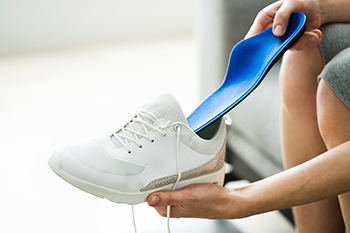
Medical devices that are placed inside the shoes for walking and running are referred to as orthotics. They are used to relieve pain from abnormal foot structures, or from having general discomfort while walking. There are several types of orthotics, and choosing the right ones depends on the condition they will be correcting. Patients who have corns and calluses may benefit from wearing epidermal insoles, which can be successful in removing pressure from the affected parts of the foot. People who desire to have a balanced distribution of weight on the feet may opt to wear comfort insoles that can absorb shock. Orthopedic insoles that are made of one piece may help patients that have flat feet, or additional specific types of deformities. If you have foot pain, and are interested in learning more about orthotics, it is suggested that you speak with a podiatrist who can determine which type is correct for you.
If you are having discomfort in your feet and would like to try orthotics, contact Shaun J. Limon, DPM and Lisa Griffith-Limon, DPM from Limons Foot & Ankle Care. Our doctors can provide the care you need to keep you pain-free and on your feet.
What Are Orthotics?
Orthotics are inserts you can place into your shoes to help with a variety of foot problems such as flat feet or foot pain. Orthotics provide relief and comfort for minor foot and heel pain but can’t correct serious biomechanical problems in your feet.
Over-the-Counter Inserts
Orthotics come in a wide variety of over-the-counter inserts that are used to treat foot pain, heel pain, and minor problems. For example, arch supports can be inserted into your shoes to help correct overarched or flat feet, while gel insoles are often used because they provide comfort and relief from foot and heel pain by alleviating pressure.
Prescription Orthotics
If over-the-counter inserts don’t work for you or if you have a more severe foot concern, it is possible to have your podiatrist prescribe custom orthotics. These high-quality inserts are designed to treat problems such as abnormal motion, plantar fasciitis, and severe forms of heel pain. They can even be used to help patients suffering from diabetes by treating foot ulcers and painful calluses and are usually molded to your feet individually, which allows them to provide full support and comfort.
If you are experiencing minor to severe foot or heel pain, it’s recommended to speak with your podiatrist about the possibilities of using orthotics. A podiatrist can determine which type of orthotic is right for you and allow you to take the first steps towards being pain-free.
If you have any questions please contact our office located in Lakewood Ranch, FL . We offer the newest diagnostic and treatment technologies for all your foot and ankle needs.
Symptoms That May Indicate Gout

Gout is an inflammatory condition that causes extreme pain in the joints and is particularly common in the big toe. Patients with gout suffer from hyperuricemia, an overabundance of uric acid in the bloodstream. Uric acid then crystallizes, forming sharp, short needles that settle in the joint and cause extreme pain. Anyone can suffer from gout, but it is more common among men over the age of 30. Risk factors for gout are genetics, alcohol use, and a diet rich in foods that contain a high level of purines. These include red meat, seafood, and beverages made with alcohol or large amounts of sugar. The top indicator of gout in the big toe is severe pain. This may come on suddenly and typically occurs at night. The intense pain can linger for days. Swelling, tenderness, and redness are also hallmarks of gout. The skin on the toe may begin to peel and then become itchy and flaky. It also may begin to feel hot to the touch. In some cases, a low-grade fever develops, along with flu-like symptoms. If you believe you may have gout in the big toe, it is suggested that you make an appointment with a podiatrist who can offer treatment options.
Gout is a foot condition that requires certain treatment and care. If you are seeking treatment, contact Shaun J. Limon, DPM and Lisa Griffith-Limon, DPM from Limons Foot & Ankle Care. Our doctors will treat your foot and ankle needs.
What Is Gout?
Gout is a type of arthritis caused by a buildup of uric acid in the bloodstream. It often develops in the foot, especially the big toe area, although it can manifest in other parts of the body as well. Gout can make walking and standing very painful and is especially common in diabetics and the obese.
People typically get gout because of a poor diet. Genetic predisposition is also a factor. The children of parents who have had gout frequently have a chance of developing it themselves.
Gout can easily be identified by redness and inflammation of the big toe and the surrounding areas of the foot. Other symptoms include extreme fatigue, joint pain, and running high fevers. Sometimes corticosteroid drugs can be prescribed to treat gout, but the best way to combat this disease is to get more exercise and eat a better diet.
If you have any questions please feel free to contact our office located in Lakewood Ranch, FL . We offer the newest diagnostic and treatment technologies for all your foot and ankle needs.




